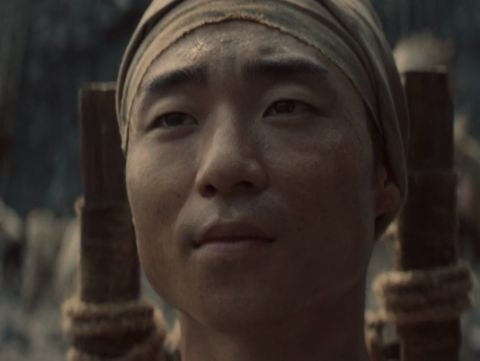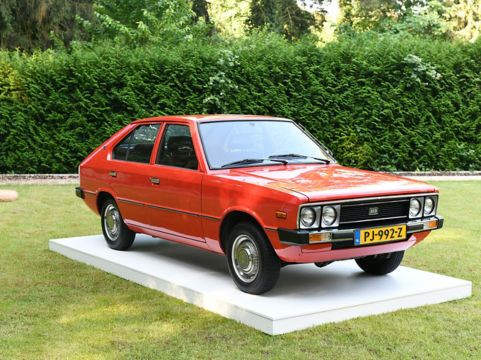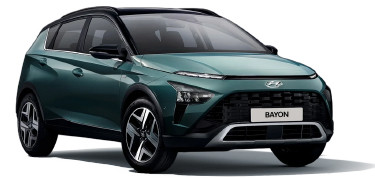
Hyundai Motor Group Vision
The history of challenge and expansion


Unlimited Sense of Responsibility

Realization of Possibilities

Respect for Mankind
The story of Hyundai Group started as a dream in Asan, a small city in Korea. While shaping its future, Chung Juyung, who has adopted the principle of creating value in his own country and subsequently everywhere he reaches, has made Hyundai a history with his devoted teamwork. Citing "passion for the better" as a source of motivation, Chung summed up the transformation of his dream into success with his words "Nothing is impossible when you break the routine".
Beginning of success - Chapter I
How a farmer boy started a global company.
Chung Ju-yung, founder of Hyundai, was born in the village of Asan, approximately 50 km north of the current demilitarized zone, in a territory that is now part of North Korea. Being the eldest of seven children, he had to take care of his siblings, which meant working with his father for 15 to 16 hours a day. He often recalled “… although we worked very hard, we often didn’t have enough food”
Chung Ju-young, however, was a born optimist and lovingly remembered how early in the morning he was happy to get up with great expectation of what he could achieve for him and his family during the day. On his father’s farm, however, he had no opportunity to put his ideas to life, and as a teenage boy he often ran away from home to Seoul, seeking new opportunities, whether he carried stones as a construction worker or loaded and unloaded ships as a port labourer. Although his father had always found him and brought him back home, Chung Ju-yung never gave up. Again and again he tried to escape from home, and after many attempts, his continued effort was finally rewarded with success. Within three years he then evolved from a messenger delivering rice to an operator and owner of a thriving rice trade in Seoul. With the advent of World War II, Chung Ju-yung was forced to give up his rice business, but his desire for a better life did not suppress it.
He set up a car service where cars were repaired five times faster than other competitors in the area. This brilliant idea was at the birth of a business that turned into a global car manufacturers which we know it today as Hyundai Motor Group.
- Engineering, Facilities
and Road Construction - Heavy Industry, Shipbuilding and Port Construction
- Hyundai Motor on the World Stage
- Social Responsibility
- Ready for the next first step

Chapter II:
Courage to go forward even in turbulent times
“I wanted to help build Korea so my children could live a better life.” Chung Ju-yung.
Korea was at war in the early 1950s. The whole country was plagued by economic and political turmoil, and investment was virtually impossible. But Chung Ju-yung had an ambitious vision of restoring his country, despite everything. His vision was also reflected in the choice of the name of his business. Hyundai in Korean means “modern times”. Chung Ju-yung founded Hyundai Civil Works in 1947 and later, in 1950, incorporated it into Hyundai Construction Company.
His first major challenge was the reconstruction of the Goryeong Bridge. Although he had no education in the field, Chung was making great progress with his desire to achieve his goals. The bridge was successfully completed and Hyundai soon won a government contract to build most of the road infrastructure in South Korea.
This success later led to the production of the first Korean car: the Pony. Chung Ju-yung has always sought even greater challenges. The other one was to win over the experts in the construction of dams in the project of the dam Soyang Dam. He had no experience, yet after studying the plans he boldly expressed the opinion that the design of a concrete dam from competing experts is not correct.

Chapter III
"Did you try?"
How did a turtle win over a skeptical committee of investors?
Hyundai is now well established in the construction industry and has successfully built most of the Korean road infrastructure. However, Chung Ju-young's vision of establishing South Korea was far from complete. He wanted to open the country to the world by expanding his foreign trade. And would it be a better idea than building a ship?
However, no cargo ship has been built in Korea before. Even an engineer learning these plans reacted with disbelief: "This is impossible!" But Chung Ju-yung didn't let him be discouraged and insisted: “How do you know if it's impossible if you haven't tried it yet?"
To secure the necessary investment for his seemingly unrealistic goal, Chung Ju-yung took a 500 won note from his wallet and showed it to an investors committee.
The bill featured the image of the famous Korean turtle ship, the world's first armored warship, built in 1592. He passed the message. Chung Ju-young's enthusiasm and innovative persuasion provided Hyundai's credits. This is how Hyundai Heavy Industries was founded in 1972.
And at this point in Hyundai's story, a question about the word arose: “Have you tried?“
A simple statement that has become a philosophy and guiding principle that still goes from success to success today for Hyundai.

Chapter V:
Construction of the country car
Chung Ju-young's car dream comes true.
“If the roads are the veins of our nation, then cars are the blood flowing through them."- Chung Ju-Yung
Hyundai has proven its competence in road and bridge construction. Now it was time to drive them.
In 1967, during the second wave of South Korea's national reconstruction project, Chung Ju-yung founded the Hyundai Motor Company. Soon, the young auto company went looking for a designer and found him in Sir George Turnbull, the former head of the British company Leyland. Hired as vice president of Hyundai Motor Company.
With its expertise, Hyundai built a technology center and a new manufacturing plant in Ulsan and needed only half of the initially planned time.
The Ulsan factory was built on a swamp. While others saw this as an obstacle, Chung Ju-yung saw it as an opportunity. As Sir George Turnbull put it at the time: “Chung Ju-yang firmly believed that if he decides something, he can achieve anything."

Chapter VII:
Progress is nothing without humanity
Chung Ju-yung repays his debt 55 years later.
Chung Ju-yung has always been concerned with the well-being of other people. In 1977 he founded the ASAN Foundation, which looks after disadvantaged people and guarantees half of his stake in Hyundai.
Another example of the will to help was the brilliant "oil tanker method" in which a tanker for scrapping was sunk to create a rice field in Seosan. One of Korea's largest land reclamation projects to date.
To enhance his homeland's reputation in the world, Chung Ju-yung became chairman of the Korean Olympic Games bidding committee in 1981. Over the next seven years, Chung Ju-yung did everything in his power, including a significant portion of his personal fortune, to promote Seoul as the host city of the 1988 Olympic Games.
But in all the examples that show his devotion, one thing stands out: Chung Ju-yung used the money his father earned as a child to escape from his North Korean village to Seoul. 55 years later, Hyundai's founder arranged with one additional cow to bring 1001 cows to the North Korean border to replace what belonged to her father.
The thought behind it: If a single cow did a lot for him, what could 1001 cows do for the people of North Korea?

Ready for the next first step
How Hyundai dreams of the future?
Some may wonder: what's next for Hyundai?
Chung Ju-yung demonstrated that at Hyundai we are not tied to an industry or product. But even today we think limitlessly. We built roads, bridges, ports and cars. Meanwhile, we rebuilt our country.
After humble beginnings, we are now on the brink of a new era of mobility with the Hyundai NEXO, the second generation of groundbreaking Hyundai fuel cell technology.
By 2030, we plan to build 500,000 fuel cell vehicles that will promote tomorrow's mobility and pave the way for the future of the automobile with new solutions.
We have achieved a lot.
And this is just the beginning..
Ready for the next first step.

What Does Hyundai Mean?
Hyundai Motor Group History
-

Chung Ju-yung, the founder of Hyundai, was born in the village of Asan, located about 30 miles north of the current demilitarized zone (DMZ) in what is now North Korea. As the oldest child of farmers he was expected to take over the family with 6 younger siblings. However, he decided to look for opportunities. He therefore fled his home three times – the last time in 1931 at the age of 18 – hoping to be able to provide a better life than his family. The first time, at the age of 16, he and a friend reached the town of Kowon and took up jobs as construction workers, Chung realised his passion for civil engineering. It went well for two months until his father learned of Chung’s whereabouts and took him back. The second time Chung and his friend were betrayed by a stranger who promised them jobs, but took all of their money instead.
-

Back in the country, however, the father realised his son’s relentless desire to see the world – and eventually let him go. From 1935 on, Chung persevered in various fields, from working as a dock worker, carrying stones to delivering rice- which required him to learn how to ride a bike. Thanks to his passionate dedication and his unwavering vision, Chung became the owner of the shop within two years. But then another challenge came up: rice trade was forbidden in Korea.
-

With the rice trade forbidden, Chung soon began a search for “something else to do that did not require large capital, but would yield high returns”. In 1941, he started a car repair shop in Seoul, his first contact with the automotive world. Even in the early 1940s, Chung’s company was just like Hyundai today: quick and efficient. He later said with pride, “we repaired in only five days what took other companies twenty”.
-

Within three years, the number of employees rose from 20 to 70, which is why the government decided to merge Chung’s business with a steel mill to support war efforts. In 1947 he started his fifth job as founder of the Hyundai Group by entering the building trade. As government contractor his company “Hyundai Engineering & Construction“ was part of the country’s rejuvenation – which of course included building roads. Chung quickly realized that if “roads are the country’s veins, cars are the blood running through them”. Chung, a farmer’s son who was never afraid of facing obstacles and starting over and over again, played an important role in rebuilding Korea and making his original vision a reality: “If someone asked me what is the motivating force for Hyundai – a desire for better.” And what about the cow? Shortly before his passing, founder Chung repaid his debt by gifting his country 1001 cows in a symbolic gesture: a tribute to his beloved father who made all of this possible.
-

In 1967, Hyundai Motor Company was founded. The following year, the construction of the company’s Ulsan assembly plant was completed. Today, it is the world’s largest integrated automobile manufacturing facility, with an annual production capacity of 1.6 million units. With a global vessel fleet operated by Hyundai Glovis and its own steel-making affiliate, Hyundai Motor Group controls the whole value chain.
-

Following the Cortina’s initial success, Hyundai was determined to develop its first car. The company hired George Turnbull, the former Managing Director of Austin Morris at British Leyland, along with a team of engineers from established European automakers. Together, they designed and built the Pony, the first mass-produced South Korean car, which was introduced to the market in December 1975.
-

The 1980s was a time of rapid expansion for Hyundai as the company became an international player and started competing with traditional automakers. The first-generation Hyundai Sonata was introduced in 1985 and in 1986, the Pony Excel became the first Hyundai model sold in the United States.
-

The 1990s saw Hyundai experiment with a number of electric and hybrid vehicles. The company’s first pure electric car was the Sonata Electric Vehicle prototype in 1991. After conducting its first experiments with hybrid propulsion systems in 1994, the hybrid-electric FGV-1 was unveiled at the 1995 Seoul Motor Show. This car featured full-time electric drive technology. Flexible-fuel vehicles were being developed in 1998, while the company’s fuel cell electric vehicle activities were also started in the late 1990s.
-

Hyundai first entered the Turkish market in 1990. In 1995, after strong demand and high sales, it established a factory in Izmit and started mass production in July 1997. Mass production started with Accent and Grace models.
-

After the millennium, Hyundai has invested in quality, design and production systems to strengthen its image as a world brand. The first SUV vehicle “Santa Fe” was launched in 2000, its success led to the emergence of “Tucson” in 2004.
-

Hyundai Assan started to export its Accents to Gulf countries.
-

Launch of the i30, the company’s first ‘i’ model developed to meet the specific demands and expectations of European consumers and provide a real challenge to the mainstream brands in the C-segment.
-

Throughout the 2010s, Hyundai has increasingly turned its attention towards environmentally friendly vehicles and technology. Going forward, the company aims to lead the pollution-free mobility era by improving fuel efficiency and seeking new energy possibilities.
-

Hyundai launched ix35 Fuel Cell, the first commercially mass-produced hydrogen fuel cell vehicle in the world. The vehicle’s quick refuelling time and long driving range, combined with its environmental conservation, provide greater benefits for all. The same year, the company also expanded into motor racing, with the launch of the Hyundai Motorsport World Rally Championship team.
-

In 2016, Hyundai introduced the IONIQ, the world’s first car to offer three electrified powertrains – hybrid, plug-in hybrid and full electric. Its name derives from the words ‘ion’ and ‘unique’.
-

The all-new i30 N marks the premiere of the new Hyundai N high performance range. Built on the New Generation i30, the i30 N has been developed from the ground up to deliver maximum driving pleasure in everyday life on the road, as well as on the track. Born in Namyang and honed at the Nürburgring. Hyundai N cars are designed to perform – and to put a grin on your face.
-

Versatile and very fun to drive, the all-new KONA Electric is the first electric compact SUV in Europe. This ground-breaking newcomer combines impressive electric driving range with bold and roomy SUV style – for no compromises.
-

Unveiled to an overfill crowd at the 2019 Frankfurt Motor Show, Hyundai’s latest concept model is a look at the future of electric mobility. Simply named 45, this new electric design concept pays homage to one of the most iconic vehicles in Hyundai’s history. The progressive 45 puts a twist on a 45-year-old icon, the Hyundai Pony Coupe Concept, to introduce an entirely new in-car experience for the self-driving vehicles of tomorrow. 45

"Nothing is impossible when you break the routin
Hyundai Grubu
Versatile corporate success
Since the foundation of Hyundai Motor Company in South Korea in 1967, the Hyundai Group
has become a global player in a variety of industries: as a steel producer, on board,
Heavy machinery and plant engineering, a logistics company and much more.
Group Activity Areas










